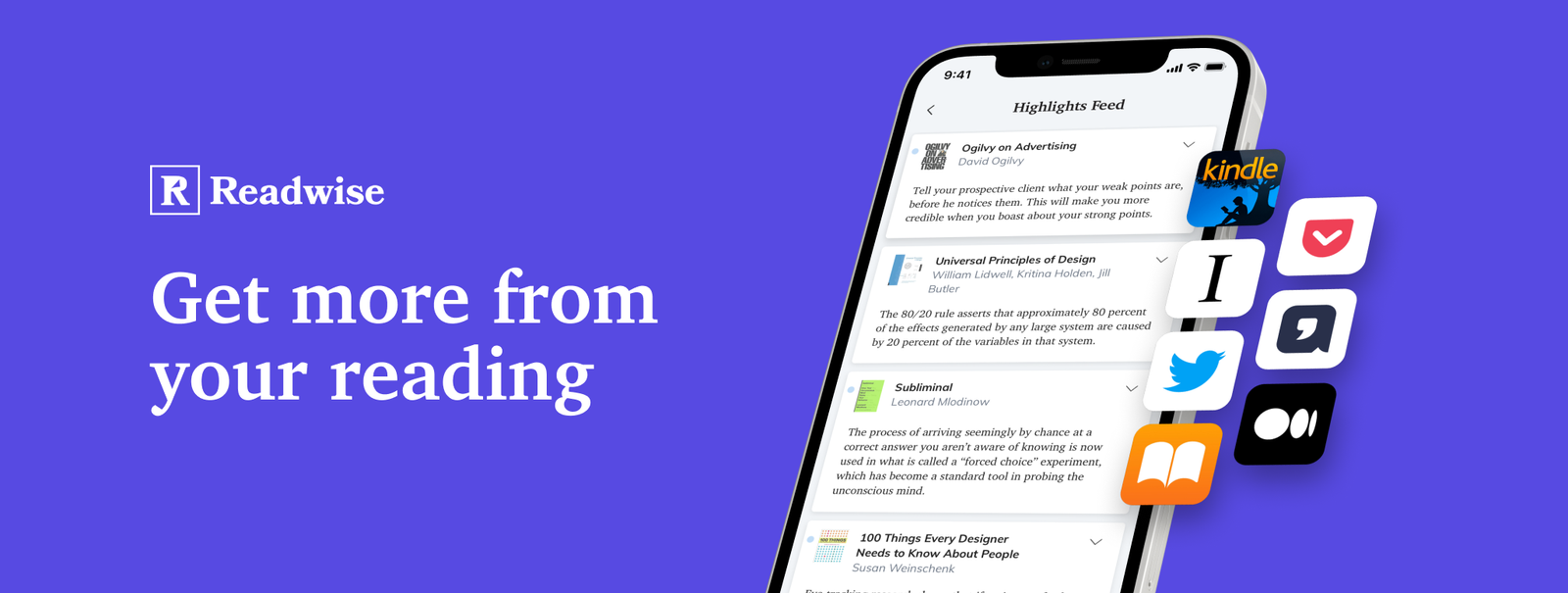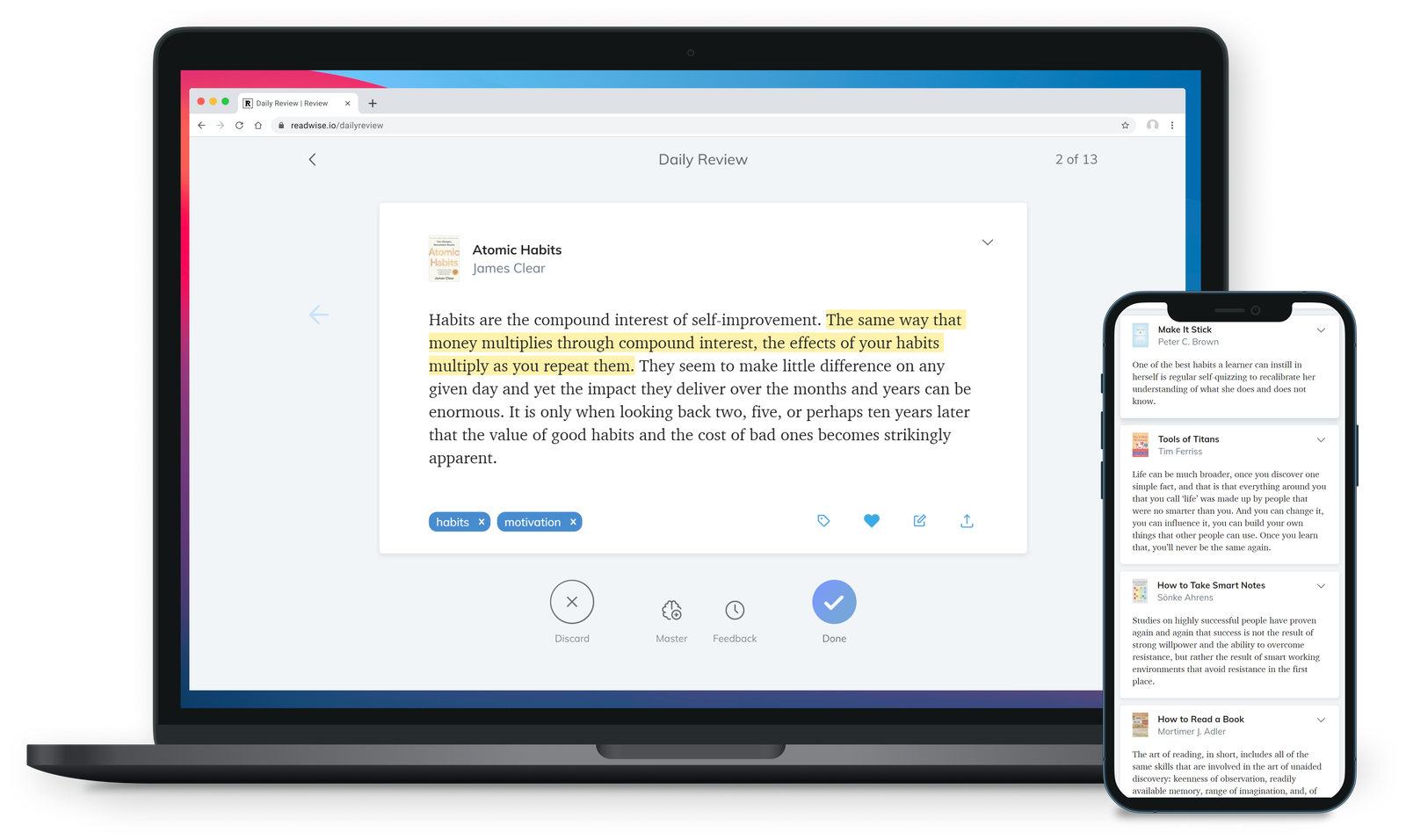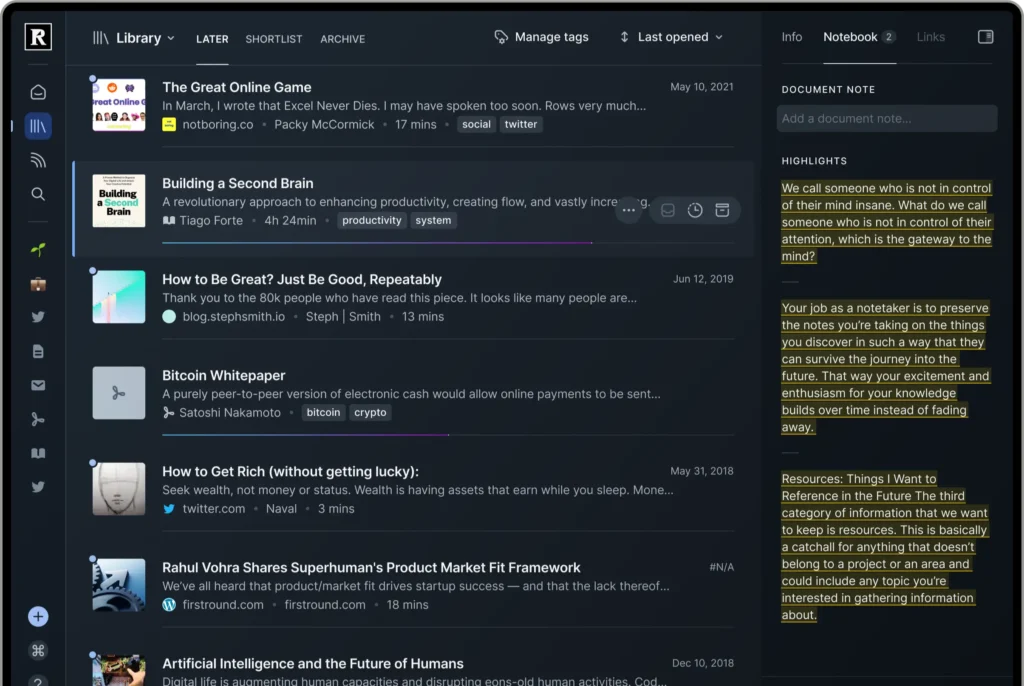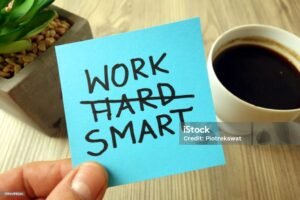Building a personal knowledge database has never been more important in today’s information-rich world. We’re consuming more personal development content than ever before.
Books, podcasts, articles, courses, videos—the opportunities for learning are endless. Yet despite this abundance of knowledge, many of us struggle to translate what we learn into meaningful change in our lives.
The stark reality is that consuming information doesn’t automatically lead to transformation. You can read dozens of self-help books each year, listen to hundreds of podcast episodes, and still find yourself implementing just a fraction of what you’ve learned. The problem isn’t a lack of quality information—it’s the absence of a system to effectively capture, retain, and apply that knowledge.
This gap between consumption and application represents one of the greatest untapped opportunities in personal development. By building an intentional knowledge management system, you can dramatically increase the return on investment from every book you read and every course you take.
In this comprehensive guide, I’ll walk you through exactly how to build a personal growth knowledge system that works—one that transforms passive consumption into active growth.
You’ll discover a four-stage framework for managing your personal development insights, the tools that make this possible, and practical strategies to ensure you actually apply what you learn.
The Personal Growth Knowledge Gap
Have you ever had this experience? You read an inspiring book, highlighting passages and making mental notes about all the ways you’ll apply these insights. You finish the book feeling motivated and clear about the changes you’ll make. Fast forward a few weeks, and you struggle to recall even the main points from the book, let alone implement them in your life.
This phenomenon is backed by cognitive science. According to the Ebbinghaus Forgetting Curve, we forget approximately 70% of what we learn within 24 hours if we don’t have a system for retention.
After a month, that number climbs to nearly 90%. These statistics help explain why so many of us can read life-changing books yet struggle to see corresponding changes in our lives.
The problem is compounded by our approach to learning. Most people engage in passive consumption—reading or listening without a structured way to process and apply that information.
Even those who take notes or highlight passages often leave those insights isolated and disconnected, stored in various apps or physical notebooks without a unified system.
This scattered approach creates several problems:
- Fragmentation: Your knowledge becomes scattered across multiple platforms and formats
- Lack of connections: You fail to see relationships between ideas from different sources
- No retrieval practice: Without regular review, you quickly forget what you’ve learned
- Implementation gap: You have no systematic way to convert insights into action
The solution isn’t to consume more content—it’s to build a system that helps you maximize the value of what you’re already consuming. A well-designed knowledge management system creates a virtuous cycle where capturing leads to connections, connections lead to understanding, and understanding leads to application.
Building Your Knowledge Management System: The 4-Stage Framework
The most effective personal growth knowledge systems follow a four-stage framework: Capture, Organize, Review, and Apply. Each stage builds upon the previous one, creating a seamless flow from initial exposure to practical implementation.
Stage 1: Capturing Knowledge Effectively
The foundation of any personal knowledge database is effective capture. Without a reliable way to collect the insights you encounter, you’ll continue to experience the frustration of forgetting valuable ideas.
Sources of Personal Development Insights
Your personal growth journey likely includes multiple sources of information:
- Books: Both physical and digital books are cornerstone resources for personal development
- Articles: Online articles, blog posts, and newsletters often contain timely, targeted insights
- Podcasts: Audio learning provides a convenient way to absorb new ideas during otherwise “dead” time
- Courses: Structured learning experiences that often contain concentrated wisdom
- Videos: Educational content on platforms like YouTube can provide valuable visual learning
- Social media: Despite the noise, platforms like Twitter and LinkedIn can be sources of useful insights
The challenge is creating a unified system that can capture insights from all these diverse sources without creating additional friction in your learning process.
Why Readwise is Essential for Capturing Highlights Across Platforms
This is where Readwise shines as an essential component of any serious personal knowledge database. Readwise is a tool specifically designed to solve the capture problem by automatically collecting your highlights and notes from virtually any reading source.
At just $5.59/month for Readwise Lite or $9.99/month for the full version (billed annually), it’s an affordable foundation for your personal knowledge database.

Here’s what makes Readwise particularly valuable for the capture stage:
- Multi-platform integration: Readwise connects with Kindle, Apple Books, Kobo, Instapaper, Pocket, and many other services, automatically importing your highlights and notes
- Physical book capture: Using the Readwise mobile app, you can quickly capture highlights from physical books by taking photos of the passages you want to save
- Web highlighting: With the Readwise browser extension, you can highlight any article or web page you’re reading online
- Podcast and video transcription: Readwise can even help you capture insights from podcasts and videos through its integration with tools like Airr (for podcasts) and other transcript services
- Email newsletters: Forward newsletter highlights directly to your Readwise account
The core value of Readwise at this stage is automation and consolidation. By automatically gathering your highlights from multiple sources into a single repository, it eliminates the friction that often prevents consistent capture. This automation ensures you build a comprehensive collection of insights without having to manually copy and paste or type out quotes from various sources.
The Importance of Automating Your Capture Process
Automation is critical for maintaining a sustainable knowledge management system. When capture requires significant manual effort, most people eventually stop doing it, regardless of their initial enthusiasm.
Readwise removes this barrier by making capture nearly effortless for digital content and significantly easier for physical materials.
By automating the capture process, you also free up mental bandwidth to focus on what really matters: understanding and applying the knowledge, rather than managing the logistics of collecting it.
Stage 2: Organizing for Clarity
Capturing information is just the first step. Without organization, you’ll end up with a digital pile of disconnected quotes and ideas—perhaps more accessible than physical notes scattered across notebooks, but still lacking the structure needed for effective retrieval and application.
Creating a Logical Structure for Your Personal Development Insights
The goal of organization is to transform random highlights into a coherent knowledge base that serves your personal growth goals. This requires categorizing and connecting information in ways that make sense for your specific journey.
A good organizational system should:
- Group related concepts together
- Make retrieval quick and intuitive
- Highlight connections between different sources
- Prioritize actionable insights
- Evolve as your knowledge and goals change

How Readwise’s Tagging and Categorization Features Work
Readwise provides powerful tools for organizing your personal development insights:
- Tags: You can add tags to individual highlights or bulk tag multiple highlights at once. This allows you to create categories like “productivity,” “emotional intelligence,” or “habit formation” that cut across different books and sources.
- Books and sources: Readwise automatically organizes highlights by their original source, maintaining context for each insight.
- Full-text search: When you need to find a specific idea, Readwise’s robust search functionality helps you locate it quickly.
- Favorites: For particularly important insights, you can mark highlights as favorites for easier retrieval.
- Custom categories: Beyond basic tagging, you can create custom organizational structures that align with your personal development framework.
These organizational features help transform a collection of disconnected highlights into a structured knowledge base that you can easily navigate and utilize.
Connecting Related Ideas Across Different Sources
One of the most powerful aspects of a centralized personal knowledge database like Readwise is the ability to see connections between ideas from different sources. By tagging similar concepts across multiple books or articles, you begin to develop a more nuanced and comprehensive understanding of key personal development principles. Readwise even offers an AI-powered “Chat With Highlights” feature that helps you explore your personal knowledge database to find new connections and insights you might otherwise miss.
For example, you might notice how different authors approach the concept of habit formation, allowing you to identify both common principles and unique perspectives. These connections often lead to deeper insights than any single source could provide.
Building a Personal Knowledge Database That Grows Over Time
As your Readwise library grows, it becomes increasingly valuable through the network effect of connected ideas. Each new book or article you read adds to this interconnected web of knowledge, creating a personal development database that becomes more powerful over time.
This growing knowledge base becomes a resource you can return to again and again, extracting different insights depending on your current focus or challenges. Rather than having to re-read entire books, you can quickly access the specific ideas most relevant to your current situation.
Stage 3: Review Systems That Actually Work
Capturing and organizing information is necessary but insufficient for true learning. Without a systematic review process, even the most carefully curated highlights will fade from memory. Effective review is what transforms passive collection into active learning.
Why Regular Review is Critical for Retention
Cognitive science has repeatedly demonstrated that spaced repetition—reviewing information at increasing intervals—dramatically improves long-term retention.
This principle is the foundation of effective learning, yet most people have no structured way to review what they’ve highlighted from books and articles.
Without review, the knowledge you’ve captured remains theoretical rather than becoming internalized understanding that influences your decisions and actions. Regular review moves information from short-term to long-term memory and helps you develop a deeper grasp of core principles.

How Readwise’s Spaced Repetition System Reinforces Learning
Readwise’s daily review feature is perhaps its most powerful tool for personal growth. The platform uses spaced repetition algorithms to automatically resurface your highlights at optimal intervals for learning. Each day, Readwise sends you a carefully selected batch of highlights to review, ensuring that valuable insights don’t get lost in your growing collection.
This spaced repetition system offers several key benefits:
- Effortless consistency: The daily email reminder creates a habit trigger for regular review
- Optimized spacing: The algorithm ensures you see highlights at intervals designed to maximize retention
- Cross-pollination: You’ll see highlights from different sources together, encouraging connections
- Resurfacing forgotten gems: Valuable insights you might otherwise never revisit are brought back to your attention
- Gradual internalization: Over time, important concepts become deeply embedded in your thinking
By making review automatic and effortless, Readwise ensures that you actually revisit the knowledge you’ve captured—something that rarely happens with traditional note-taking methods.
Stress Management: Turn Chaos into Career-Changing Results
Creating Actionable Review Practices
Beyond Readwise’s automated system, you can enhance your review practice by:
- Setting aside 10-15 minutes each day for your Readwise review
- Taking notes on new connections or insights that arise during review
- Reflecting on how reviewed highlights apply to current challenges or projects
- Creating accountability by sharing key insights with friends or an online community
- Tracking which highlights repeatedly resonate with you over time
Turning Passive Highlights into Active Learning Materials
As you review, focus on transforming passive highlights into active learning experiences:
- Ask questions about the highlighted material
- Look for connections to your current situation
- Consider counterarguments or limitations
- Restate key concepts in your own words
- Identify specific applications in your life
These active engagement strategies dramatically increase the value of your review sessions, moving beyond recognition (“I remember this”) to deeper processing and application.
The Forgotten Art of Getting Lost.. A Guide
Stage 4: Application and Implementation
The ultimate goal of any personal growth knowledge system is application—actually using what you’ve learned to improve your life and work. Without this final stage, even the most sophisticated capture, organization, and review system remains an intellectual exercise rather than a catalyst for change.
Moving from Knowledge to Action
Application requires intentionally bridging the gap between knowing and doing. This means:
- Translating abstract principles into concrete actions
- Integrating new insights into existing habits and systems
- Creating implementation plans for valuable ideas
- Tracking results and iterating based on real-world feedback
How to Use Readwise Exports in Your Productivity System
Readwise facilitates application by allowing you to export your highlights and notes to your preferred productivity system:
- Note-taking apps: Export to Notion, Evernote, Obsidian, Roam Research, or other notes apps
- Task managers: Send actionable items to tools like Todoist or Things
- Writing platforms: Export to writing environments for content creation
- Custom workflows: Use the Readwise API for advanced integrations
These export capabilities allow you to move from insight to action, incorporating what you’ve learned into your existing workflows and systems.
Creating Action Items from Your Highlights
As you review highlights, actively look for opportunities to convert insights into specific actions:
- Create tasks based on strategies you want to implement
- Set up experiments to test ideas in your own context
- Schedule time blocks for practicing new techniques
- Establish metrics to track the impact of applied knowledge
For example, if you encounter a highlight about a specific productivity technique, don’t just admire the idea—schedule a time to try it, define what success would look like, and create a reminder to evaluate the results.
Building Personal Projects Based on What You’ve Learned
For deeper application from your personal knowledge database, consider creating projects that allow you to synthesize and apply multiple related insights:
- Design a morning routine incorporating elements from several sources
- Create a personal manifesto that integrates your most meaningful highlights
- Develop a workshop or presentation to teach key concepts to others
- Write articles that connect and expand upon ideas from different books
These projects force you to engage with the material at a much deeper level than passive consumption ever could.
Integrating Readwise with Other Tools
While Readwise excels at capturing and reviewing highlights, a complete personal growth knowledge system typically involves multiple tools working together. The key is creating an integrated workflow where information flows seamlessly between different components of your system.
Connecting Readwise with Note-taking Apps
Readwise’s integration capabilities allow you to create powerful combinations with your preferred note-taking platform:
- Readwise + Notion: Automatically sync highlights to a Notion database where you can further categorize, connect, and act on insights
- Readwise + Obsidian: Create a personal knowledge graph that visually maps connections between ideas
- Readwise + Evernote: Combine highlighted passages with your own notes in a searchable personal archive
- Readwise + Roam Research: Build a networked thought system with bidirectional links between concepts
These integrations extend Readwise’s functionality, combining its capture and review strengths with the organizational and application capabilities of dedicated note-taking platforms.
Building Automation Workflows with Readwise
For advanced users, automation tools can further enhance your knowledge system:
- Use Zapier or IFTTT to trigger actions based on new Readwise highlights
- Create templates that transform highlights into standardized note formats
- Set up periodic exports to maintain synchronized systems
- Build custom digests of highlights related to current projects or goals
Automation reduces friction in your system, making it more likely that you’ll maintain it long-term.
Creating a Seamless System that Reduces Friction
The most effective knowledge systems minimize friction at every stage:
- Capture: Should be automatic or require minimal effort
- Organization: Should leverage automated tagging and categorization
- Review: Should be scheduled and prompted with reminders
- Application: Should integrate with existing productivity workflows
By designing your system to be low-friction, you ensure that it becomes a sustainable part of your personal growth practice rather than another abandoned productivity experiment.
Real Examples of Integrated Knowledge Systems
Here are a few examples of how different knowledge workflows might look in practice:
Example 1: The Minimalist Approach
- Capture: Kindle highlights sync automatically to Readwise
- Organize: Basic tagging in Readwise by topic
- Review: Daily Readwise email review
- Apply: Monthly reflection on top highlights, with action items added to task manager
Example 2: The Connected Notes Approach
- Capture: Readwise collects highlights from Kindle, physical books, and articles
- Organize: Export to Obsidian with automated tagging
- Review: Combination of daily Readwise emails and weekly Obsidian review
- Apply: Create “action note” documents for implementing specific concepts
Example 3: The Content Creator Approach
- Capture: Comprehensive highlight collection in Readwise
- Organize: Export to Notion with detailed categorization and rating system
- Review: Scheduled review sessions focused on specific topics
- Apply: Transform insights into blog posts, videos, and workshops
Each of these systems leverages Readwise’s strengths while adapting the overall workflow to individual preferences and goals.
Get your extended 60-day free trial of Readwise
My Personal System: A Case Study
To make these concepts more concrete, let me share my own knowledge management system and how it supports my personal development journey.
Overview of My Own Knowledge Management System
My personal knowledge database has evolved over time, but the current iteration includes:
- Capture: Readwise collects all my highlights from Kindle books, physical books (via the app), articles (via the browser extension), and newsletters (via email forwarding)
- Organize:
- Initial organization happens in Readwise with a tagging system based on key personal development domains (productivity, psychology, relationships, etc.)
- Weekly, I export selected highlights to Notion, where I maintain a more detailed database
- Review:
- Daily: I spend 10 minutes with the Readwise daily review
- Weekly: I review a specific topic area in my Notion database
- Monthly: I conduct a more comprehensive review, focusing on implementation opportunities
- Apply:
- I maintain an “Insights to Actions” database in Notion where I convert key highlights into specific experiments
- I track the results of these experiments, noting what works in my specific context
- I share the most valuable insights through Growlogue, forcing me to articulate and synthesize what I’ve learned
How I Use Readwise as the Central Capturing Hub
Readwise serves as the foundation of my system for several reasons:
- Unified collection: All my reading insights, regardless of source, end up in one searchable database
- Effortless capture: The automated syncing means I never have to manually transfer highlights
- Thoughtful surfacing: The daily review brings up insights I’d otherwise forget
- Cross-pollination: Seeing highlights from different sources together sparks new connections
- Flexible export: I can easily move selected highlights to other tools for deeper processing
The Measurable Improvements in Retention and Application
Since implementing this system with Readwise at its core, I’ve experienced several quantifiable improvements:
- Increased recall: I can now recall key concepts from books I read months or even years ago
- More connections: I regularly notice patterns and relationships between ideas from different sources
- Higher implementation rate: I’ve gone from applying perhaps 10% of what I read to closer to 40%
- Content creation efficiency: The time required to create in-depth articles has decreased by approximately 30%
- Compounding knowledge: My understanding of core personal development concepts has deepened through repeated exposure and connection
Before and After Results
Before building this system:
- I’d read books, feel temporarily inspired, but struggle to recall specific insights weeks later
- My notes were scattered across multiple apps, physical notebooks, and Kindle highlights
- I rarely revisited highlights after completing a book
- I had to re-read entire books to find specific concepts
After implementing the system:
- I maintain a growing database of over 5,000 carefully organized highlights
- I can quickly retrieve specific concepts when needed for problem-solving or content creation
- I regularly experience “serendipitous connections” between seemingly unrelated ideas
- I’ve developed a much deeper understanding of recurring themes in personal development
- I can track my intellectual journey and see how my focus areas have evolved over time
Common Mistakes to Avoid
As you build your own personal growth knowledge system, be aware of these common pitfalls that can undermine even the best intentions.
Over-highlighting Without Processing
Many people fall into the trap of highlighting extensively without processing what they highlight. While Readwise makes it easy to capture large volumes of text, the value comes from quality, not quantity.
Solution: Be selective in your highlighting, focusing on actionable insights and truly novel ideas. When reviewing, spend time processing each highlight rather than simply skimming through large batches.
Building Complex Systems That You Won’t Maintain
It’s tempting to create elaborate knowledge management systems with multiple tools and complex workflows. However, these sophisticated systems often collapse under their own weight.
Solution: Start simple and add complexity only as needed. A basic system you actually use is infinitely more valuable than a perfect system you abandon. Let your system evolve organically based on your actual usage patterns.
Failing to Schedule Review Time
Even with Readwise’s automated review feature, many people fail to allocate dedicated time for thoughtful review, reducing the effectiveness of their knowledge system.
Solution: Schedule specific review sessions in your calendar—daily, weekly, and monthly reviews with different focuses. Treat these as non-negotiable appointments with yourself.
Not Connecting Knowledge to Action
The most common mistake is treating knowledge management as an end in itself rather than a means to actual implementation and behavior change.
Solution: For every review session, identify at least one specific action you can take based on what you’ve reviewed. Create a systematic way to track these actions and their results.
Getting Started: Your First 30 Days
If you’re inspired to build your own personal growth knowledge system with Readwise at its core, here’s a step-by-step plan for your first month:
Days 1-7: Setup and Initial Capture
- Sign up for Readwise using our special 60-day free trial link
- Connect your reading sources:
- Link your Kindle account
- Install the browser extension for article highlighting
- Set up email forwarding for newsletters
- Download the mobile app for capturing from physical books
- Import your existing highlights from Kindle, Instapaper, Pocket, or other services
- Start your daily review habit by spending 5-10 minutes each morning with your Readwise daily review
Days 8-15: Basic Organization
- Create a simple tagging system in Readwise with 5-10 main categories that align with your personal growth interests
- Begin tagging highlights during your daily review
- Explore connection options with your preferred note-taking app (Notion, Evernote, Obsidian, etc.)
- Set up your first automated export to your chosen secondary tool
Days 16-23: Developing Review Habits
- Establish a consistent daily review time and make it a non-negotiable part of your routine
- Start a weekly review session focused on a specific topic area
- Create a simple reflection template that prompts you to identify:
- Key insights from your reviews
- Potential applications in your current circumstances
- Connections between different highlights
- Begin tracking which highlights repeatedly resonate with you
Days 24-30: Implementation Focus
- Create an “Action Items” collection in your note-taking system
- For each daily review, identify at least one actionable insight
- Schedule specific times to implement these insights
- Develop a simple tracking system to monitor which implemented ideas create actual value
- Review your entire workflow and make any necessary adjustments
By the end of these 30 days, you’ll have established the foundation of a personal growth knowledge system that will serve you for years to come. As with any system, expect to refine it over time based on what works best for your specific needs and preferences.
The Forgotten Art of Getting Lost.. A Guide
Conclusion
In a world where information is abundant but wisdom is scarce, the ability to effectively capture, retain, and apply knowledge is perhaps the most valuable meta-skill you can develop. A well-designed personal knowledge database doesn’t just help you remember what you read—it transforms how you think, decide, and act.
Readwise offers two affordable plans to help you build your personal knowledge database: Readwise Lite at $5.59/month and full Readwise at $9.99/month (billed annually). Both plans give you access to the powerful Daily Review feature, while the full version adds tagging, note-taking, and the Readwise Reader app.
With Readwise as the foundation of your system, you overcome the forgetting curve that plagues most learners. Instead of losing 90% of what you read, you build a growing repository of insights that compound over time. Each book, article, and podcast becomes not just a temporary input but a permanent contributor to your evolving understanding.
The benefits of this approach extend far beyond better recall:
- Connected thinking: You’ll naturally develop more nuanced, interconnected mental models
- Accelerated growth: You’ll implement more of what you learn, creating faster progress
- Resource leverage: You’ll extract significantly more value from every book and course
- Personalized wisdom: You’ll develop unique insights from the combinations of ideas you encounter
- Intellectual confidence: You’ll build a reliable system for capturing and retrieving knowledge
Perhaps most importantly, you’ll experience the satisfaction of seeing your knowledge translate into actual improvements in your life, relationships, and work.
Special Offer for Growlogue Readers
To help you get started with building your personal knowledge database, Readwise has provided an exclusive extended trial for Growlogue readers. Instead of the standard 30-day trial, you’ll get a full 60 days (two months) to experience all of Readwise’s personal knowledge database features before deciding if it’s right for you.
Get your extended 60-day free trial of Readwise
Note: As a Growlogue affiliate partner, I earn a commission of 33% of the first year of subscription revenue when you sign up through this link. This helps support the creation of in-depth content like this while costing you nothing extra.


















